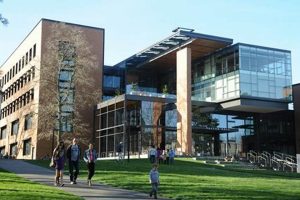High-quality middle schools provide a crucial bridge between elementary and high school education. These institutions typically serve students in grades 6-8, offering a structured learning environment with a focus on core academic subjects, including mathematics, language arts, science, and social studies. Often, they also incorporate exploratory programs in areas like art, music, and physical education, fostering well-rounded development. A strong middle school experience equips students with essential skills and knowledge, preparing them for the academic rigors of high school and beyond.
The success of middle schools is integral to a thriving education system. Effective middle schools cultivate critical thinking, problem-solving abilities, and collaboration skills, empowering students to become successful learners. Historically, the middle school model evolved to address the unique developmental needs of adolescents, recognizing the importance of a supportive and challenging learning environment during this transitional phase. Schools emphasizing academic excellence, character development, and a nurturing environment contribute significantly to student success and long-term societal advancement.
This article will explore key factors that contribute to exceptional middle school education, including curriculum design, teacher quality, extracurricular activities, and community involvement. It will also examine the various assessment metrics used to evaluate school performance and identify successful educational practices. Furthermore, the article will discuss the role of parental involvement and community support in fostering a positive learning environment.
Tips for Selecting a Quality Middle School
Choosing the right middle school is a pivotal decision that significantly impacts a student’s academic trajectory and overall development. Careful consideration of several key factors can assist families in making informed choices.
Tip 1: Assess Academic Rigor: Examine the curriculum’s depth and breadth. Look for schools offering challenging coursework aligned with state standards and opportunities for advanced learning.
Tip 2: Evaluate Teacher Quality: Research the school’s faculty. Consider teacher experience, qualifications, and professional development opportunities. Strong teaching significantly influences student achievement.
Tip 3: Investigate Extracurricular Activities: Explore the range of extracurricular offerings. A diverse selection of clubs, sports, and arts programs enriches the learning experience and caters to varied interests.
Tip 4: Consider School Culture and Climate: Visit the school and observe the interactions between students and staff. A positive and supportive school environment fosters student well-being and academic success.
Tip 5: Assess School Safety and Security: Inquire about safety protocols and procedures. A secure learning environment is essential for student focus and overall well-being.
Tip 6: Review School Performance Data: Examine standardized test scores, graduation rates, and other relevant metrics. Data-driven insights can offer valuable perspectives on school effectiveness.
Tip 7: Seek Community Input: Connect with current parents and students to gather firsthand perspectives. Community feedback can provide valuable insights into the school’s strengths and weaknesses.
By considering these factors, families can identify schools that align with their values and provide a supportive environment for their children’s educational journey. A well-chosen middle school experience lays a strong foundation for future academic success.
The subsequent sections will delve deeper into specific aspects of middle school education and offer further guidance for parents and students navigating this crucial educational phase.
1. Academic Performance
Academic performance serves as a crucial indicator of a middle school’s effectiveness. High levels of achievement in core subjects like math, science, language arts, and social studies often correlate with strong instructional practices, a rigorous curriculum, and a supportive learning environment. Schools demonstrating consistent growth in student test scores and proficiency levels often exhibit a commitment to educational excellence. For example, schools implementing data-driven instruction, providing targeted interventions for struggling students, and offering advanced learning opportunities tend to cultivate higher academic outcomes. While standardized test scores offer valuable insights, a comprehensive evaluation should also consider factors like graduation rates, college readiness, and participation in advanced coursework.
The relationship between academic performance and highly regarded middle schools is multifaceted. Strong academic outcomes not only reflect effective teaching and learning but also contribute to a positive school culture. When students experience academic success, their motivation and engagement increase, fostering a cycle of continuous improvement. Moreover, high-performing schools often attract dedicated educators and involved families, further enhancing the learning environment. For instance, schools with established programs for gifted students or robust STEM initiatives can draw students seeking challenging academic experiences. This, in turn, creates a vibrant learning community where students are encouraged to excel.
Understanding the significance of academic performance is essential for stakeholders seeking to improve educational outcomes. By analyzing data, identifying best practices, and implementing targeted interventions, schools can create environments conducive to student success. However, it is crucial to acknowledge that academic performance is not the sole indicator of a successful middle school. Factors such as student well-being, social-emotional development, and access to extracurricular activities also play vital roles in a comprehensive education. A balanced approach that prioritizes both academic excellence and holistic student development ultimately contributes to creating thriving middle schools.
2. Teacher Quality
Teacher quality stands as a cornerstone of high-performing middle schools. Effective educators possess a deep understanding of their subject matter, coupled with the pedagogical skills to convey knowledge effectively. Highly qualified teachers create engaging learning environments that foster critical thinking, problem-solving, and collaboration. Their ability to differentiate instruction to meet diverse learning needs ensures that all students have the opportunity to succeed. Research consistently demonstrates a strong correlation between teacher quality and student achievement. For example, studies have shown that students assigned to highly effective teachers consistently outperform their peers in standardized tests and demonstrate greater academic growth. This impact underscores the significance of recruiting, retaining, and supporting excellent educators within Michigan’s middle schools.
The presence of skilled and dedicated teachers distinguishes exceptional middle schools. Beyond content expertise, effective middle school teachers understand the unique developmental needs of adolescents. They create supportive classroom environments where students feel safe to take risks, ask questions, and explore new ideas. Mentorship, both academic and personal, plays a crucial role in student success during these formative years. A teacher’s ability to connect with students, build rapport, and foster a sense of belonging can significantly influence a student’s academic trajectory and overall well-being. Schools prioritizing teacher professional development and offering ongoing support create a culture of continuous improvement, ultimately benefiting students.
Investing in teacher quality is an investment in the future of Michigan’s students. Attracting and retaining talented educators requires competitive salaries, comprehensive benefits, and opportunities for professional growth. Furthermore, providing ongoing support, mentoring programs, and collaborative work environments empowers teachers to thrive and excel in their profession. Recognizing and rewarding exceptional teaching not only benefits individual educators but also elevates the entire education system. By prioritizing teacher quality, Michigan’s middle schools can ensure that all students receive the high-quality education they deserve, preparing them for future success.
3. Curriculum Breadth
A comprehensive and well-rounded curriculum is a hallmark of high-performing middle schools. Curriculum breadth, encompassing a wide range of subjects and learning experiences, plays a crucial role in fostering intellectual curiosity, developing diverse skill sets, and preparing students for the rigors of high school and beyond. A broad curriculum exposes students to various disciplines, allowing them to explore their interests and discover their aptitudes. This exploration is essential for fostering well-rounded individuals equipped to navigate a complex and ever-evolving world. In the context of Michigan’s middle schools, curriculum breadth serves as a key differentiator, setting apart exceptional institutions that prioritize holistic student development.
- Core Academic Subjects:
A strong foundation in core subjectsmathematics, science, language arts, and social studiesforms the bedrock of a quality middle school education. Rigorous coursework in these areas equips students with essential knowledge and skills, preparing them for future academic pursuits. For example, a robust math curriculum might encompass algebra, geometry, and statistics, providing students with the analytical and problem-solving skills crucial for success in STEM fields. Similarly, comprehensive language arts instruction cultivates critical reading, effective writing, and persuasive communicationskills essential for success in any field.
- STEM Education (Science, Technology, Engineering, and Mathematics):
STEM education has emerged as a critical component of a 21st-century curriculum. Middle schools offering robust STEM programs provide students with hands-on learning experiences, fostering innovation, critical thinking, and problem-solving skills. Robotics clubs, coding classes, and science fairs exemplify the types of enriching activities that engage students and prepare them for future careers in high-demand fields. Michigan’s focus on STEM education reflects the growing recognition of its importance in preparing students for a technology-driven global economy.
- Arts and Humanities:
While STEM fields receive increasing emphasis, the arts and humanities remain essential components of a well-rounded education. Exposure to visual arts, music, theater, and literature cultivates creativity, critical thinking, and cultural understanding. These disciplines nurture imagination, empathy, and communication skills, fostering well-rounded individuals capable of appreciating diverse perspectives and contributing meaningfully to society. Middle schools prioritizing arts and humanities education provide students with opportunities to explore their creative talents and develop a lifelong appreciation for the arts.
- Physical Education and Health:
Physical education and health classes contribute significantly to student well-being. These courses promote physical fitness, healthy habits, and an understanding of the human body. Engaging students in physical activity, teaching them about nutrition, and promoting mental and emotional well-being are essential for fostering healthy lifestyles. Middle schools prioritizing physical education and health create a culture of wellness, equipping students with the knowledge and skills to make healthy choices throughout their lives.
A broad and balanced curriculum, encompassing these diverse areas of study, is a defining characteristic of successful middle schools. By providing students with a wide range of learning experiences, these schools foster intellectual curiosity, cultivate essential skills, and prepare students for success in high school, college, and beyond. A commitment to curriculum breadth reflects a dedication to holistic student development, recognizing that education extends beyond academics to encompass the intellectual, social, emotional, and physical growth of each student. This comprehensive approach to education is essential for preparing Michigan’s youth to thrive in a complex and ever-changing world.
4. Extracurricular Activities
Extracurricular activities represent a vital component of a well-rounded middle school education, complementing academic learning and contributing significantly to student development. In the context of Michigan’s best middle schools, robust extracurricular programs offer students opportunities to explore interests, develop new skills, and cultivate social-emotional growth. These activities extend learning beyond the classroom, fostering a sense of belonging, promoting teamwork, and enhancing leadership skills. The availability and quality of extracurricular offerings often distinguish exceptional middle schools from their counterparts.
- Skill Development:
Extracurricular activities provide avenues for students to develop specialized skills not typically addressed in core academic subjects. Participation in band, orchestra, or choir cultivates musical talent and teamwork. Involvement in sports enhances physical fitness, strategic thinking, and collaboration. Engagement in debate club fosters critical thinking, public speaking, and persuasive communication. These specialized skills enhance students’ overall development and prepare them for future academic and professional pursuits.
- Social-Emotional Growth:
Extracurricular activities offer unique opportunities for social-emotional development. Participating in clubs, teams, or organizations allows students to build friendships, develop social skills, and learn to navigate social dynamics. The shared experiences and collaborative nature of extracurricular activities foster a sense of belonging and community, contributing to a positive school climate. Furthermore, student government, leadership roles in clubs, and participation in community service projects cultivate leadership skills, empathy, and civic responsibility.
- Exploration of Interests:
Middle school represents a crucial period for self-discovery. Extracurricular activities provide a platform for students to explore diverse interests and discover hidden talents. Exposure to a wide range of activitiesfrom robotics clubs to drama productions, from art classes to coding workshopsallows students to identify passions and develop skills in areas they may not have otherwise encountered. This exploration fosters intellectual curiosity, encourages lifelong learning, and can influence future academic and career choices.
- Academic Enrichment:
While not directly academic, many extracurricular activities provide valuable enrichment that supports classroom learning. Participation in science clubs can deepen understanding of scientific concepts. Involvement in debate club can enhance critical thinking and communication skills applicable across all subjects. Engagement in the arts can foster creativity and problem-solving skills valuable in various academic disciplines. These connections between extracurricular pursuits and academic learning contribute to a more holistic and engaging educational experience.
The breadth and quality of extracurricular programs serve as an indicator of a middle school’s commitment to fostering well-rounded individuals. Michigan’s best middle schools recognize the integral role extracurricular activities play in student development. By providing diverse and enriching opportunities outside the classroom, these schools create an environment where students can thrive academically, socially, and emotionally, preparing them for future success.
5. School Safety
School safety is paramount to a quality middle school education. A secure environment is essential for effective learning and overall student well-being. In Michigan, top-performing middle schools prioritize safety through comprehensive strategies encompassing physical security measures, emergency preparedness protocols, and programs promoting a positive school climate. The connection between school safety and educational excellence is undeniable; students cannot thrive academically or socially if they do not feel safe. For instance, schools implementing robust security measures, such as controlled access points and active shooter drills, create a more secure learning environment. Similarly, schools fostering a positive and inclusive school climate through anti-bullying programs and character education initiatives can reduce incidents of violence and disruption, further enhancing safety.
Effective school safety programs address both physical security and the social-emotional well-being of students. Measures such as security cameras, visitor check-in procedures, and trained security personnel contribute to a secure physical environment. Equally crucial are initiatives promoting positive social interactions, respectful communication, and conflict resolution skills. These programs can include peer mediation, anti-bullying campaigns, and character education curricula. For example, a school implementing a comprehensive anti-bullying program might train staff to recognize and address bullying behavior, establish clear reporting procedures, and provide support services for both victims and perpetrators of bullying. Such multifaceted approaches create a safer and more supportive learning environment, contributing to improved academic outcomes and overall student well-being.
A safe and supportive learning environment is not merely a desirable attribute but a fundamental requirement for effective education. Michigan’s best middle schools recognize that school safety is intrinsically linked to student success. By prioritizing comprehensive safety measures and fostering a positive school climate, these schools create environments where students can focus on learning and reach their full potential. Investing in school safety is an investment in the future of Michigan’s students, ensuring they have the opportunity to thrive academically, socially, and emotionally.
6. Student Support Services
Comprehensive student support services are a defining characteristic of high-performing middle schools in Michigan. These services play a crucial role in addressing the diverse academic, social, emotional, and physical needs of adolescents during this pivotal developmental stage. Effective support systems contribute significantly to student success, fostering a positive learning environment where all students feel supported and empowered to reach their full potential. A strong correlation exists between access to quality support services and positive outcomes such as improved academic performance, increased graduation rates, and enhanced social-emotional well-being. For example, schools providing comprehensive counseling services, academic interventions, and special education programs often witness significant improvements in student achievement and overall school climate. These services act as a safety net, ensuring that students facing challenges receive the individualized support they need to thrive.
The range of student support services offered in Michigan’s best middle schools reflects a commitment to holistic student development. Academic support may include tutoring programs, individualized learning plans, and specialized instruction for students with learning differences. Counseling services address social-emotional needs, providing guidance and support to students navigating challenges related to peer relationships, family dynamics, and personal well-being. Health services ensure students have access to physical and mental healthcare, promoting overall wellness and addressing any health concerns that may impact learning. For instance, a school offering a comprehensive counseling program might provide individual and group counseling sessions, crisis intervention services, and parent education workshops. These services address the multifaceted needs of students, fostering resilience and promoting positive mental health.
Investing in robust student support services is an investment in the future of Michigan’s youth. These services are essential for creating equitable learning environments where all students have the opportunity to succeed, regardless of background or individual challenges. By addressing the diverse needs of adolescents, providing targeted interventions, and fostering a culture of support, Michigan’s best middle schools ensure that no student is left behind. This commitment to student well-being is a key factor distinguishing exceptional middle schools and contributing to their overall success. The long-term benefits extend beyond improved academic outcomes, encompassing enhanced social-emotional development, increased graduation rates, and greater success in post-secondary education and future careers.
7. Community Involvement
Strong community involvement serves as a hallmark of high-performing middle schools in Michigan. Active participation from parents, local businesses, and community organizations enriches the educational experience, providing valuable resources and fostering a supportive learning environment. This collaborative approach strengthens school-community ties, benefiting students, families, and the broader community. The level of community engagement often distinguishes exceptional middle schools, reflecting a shared commitment to educational excellence.
- Parent Engagement:
Parental involvement plays a crucial role in student success. Active parent-teacher associations (PTAs), volunteer opportunities in classrooms and school events, and open communication channels between parents and educators contribute to a strong home-school connection. Research consistently demonstrates a positive correlation between parental involvement and student achievement. When parents are actively engaged in their children’s education, students tend to perform better academically, exhibit improved behavior, and demonstrate greater motivation. Schools facilitating parent involvement through workshops, communication platforms, and opportunities for shared decision-making create a collaborative environment where families and educators work together to support student learning.
- Business Partnerships:
Partnerships with local businesses provide valuable resources and real-world learning opportunities. Businesses can offer mentorship programs, internships, job shadowing experiences, and financial support for school initiatives. These partnerships expose students to various career paths, connect classroom learning to real-world applications, and provide valuable insights into the local workforce. For example, a partnership with a local technology company might involve mentoring students in coding and software development, providing valuable skills and inspiring future career aspirations. Such collaborations enhance the educational experience and prepare students for future success in the workforce.
- Community Organization Collaboration:
Collaboration with community organizations enriches educational opportunities and provides valuable support services. Local nonprofits, cultural institutions, and service organizations can offer after-school programs, tutoring services, mentoring opportunities, and access to community resources. These partnerships expand learning beyond the classroom, expose students to diverse perspectives, and connect schools to the broader community. For instance, a partnership with a local museum might involve field trips, workshops led by museum educators, and opportunities for students to engage in community-based projects. Such collaborations enhance learning and foster a sense of civic engagement.
- Volunteerism:
Volunteers contribute significantly to the success of Michigan’s middle schools. Community members donating their time and expertise can support classroom instruction, assist with extracurricular activities, mentor students, and contribute to school improvement initiatives. Volunteers bring diverse skills and perspectives to the school environment, enriching the learning experience for all students. For example, retired professionals might volunteer to tutor students in specific subjects, sharing their knowledge and experience. Such contributions enhance the educational environment and strengthen the connection between the school and the community.
Robust community involvement distinguishes Michigan’s best middle schools. These schools actively cultivate partnerships, recognizing that a strong school-community connection is essential for student success. By engaging parents, businesses, community organizations, and volunteers, these schools create a supportive and enriching learning environment that prepares students to thrive academically, socially, and civically. This collaborative approach fosters a sense of shared responsibility for education, benefiting not only individual students but also the broader community.
Frequently Asked Questions about High-Performing Middle Schools in Michigan
This section addresses common inquiries regarding high-performing middle schools in Michigan, providing concise and informative responses to assist families in navigating the educational landscape.
Question 1: How are “best” middle schools determined in Michigan?
Numerous factors contribute to a middle school’s effectiveness. Common metrics include standardized test scores, student growth percentiles, graduation rates, and participation in advanced coursework. School climate surveys, extracurricular participation rates, and teacher qualifications also offer valuable insights. No single metric defines “best,” but a combination of factors provides a comprehensive evaluation.
Question 2: What role do standardized tests play in evaluating middle school quality?
Standardized tests offer a snapshot of student performance in core subjects. While valuable for assessing overall academic achievement, they should not be the sole determinant of a school’s quality. Other factors, including student growth, curriculum rigor, and teacher quality, must be considered for a complete evaluation.
Question 3: How can parents contribute to middle school success?
Parental involvement significantly impacts student outcomes. Active participation in school events, open communication with teachers, and creating a supportive home learning environment foster academic success and social-emotional well-being. Engaging with the school community and advocating for student needs further strengthens the educational experience.
Question 4: What support services are typically available in high-performing middle schools?
High-performing schools typically offer a range of support services, including academic counseling, tutoring programs, special education services, and mental health resources. These services address diverse student needs, promoting academic success and overall well-being. The availability of comprehensive support systems enhances the learning environment and ensures students receive individualized attention.
Question 5: How does school climate impact student learning?
A positive school climate fosters a sense of belonging, safety, and respect, creating an environment conducive to learning. Schools promoting positive relationships between students and staff, implementing anti-bullying programs, and fostering a culture of inclusivity often experience higher levels of student engagement and academic achievement.
Question 6: What are the long-term benefits of attending a high-performing middle school?
Attending a high-performing middle school provides a strong foundation for future academic success. Students benefit from rigorous academics, dedicated teachers, and a supportive learning environment. This foundation prepares them for the challenges of high school, college, and beyond, increasing their likelihood of graduation, post-secondary enrollment, and career success.
Understanding these aspects empowers families to make informed decisions about their children’s education. Thorough research and careful consideration of individual student needs are essential for selecting the right middle school environment.
The following section will explore specific examples of high-performing middle schools in Michigan, showcasing successful programs and highlighting best practices.
Conclusion
This exploration of high-performing middle schools in Michigan has highlighted key factors contributing to educational excellence. Academic rigor, teacher quality, curriculum breadth, extracurricular opportunities, school safety, student support services, and community involvement collectively shape successful learning environments. Understanding these elements empowers families to make informed decisions when choosing a middle school. Effective middle schools prioritize not only academic achievement but also the holistic development of young adolescents, preparing them for future success.
The pursuit of educational excellence requires ongoing commitment and collaboration among educators, families, and communities. Investing in Michigan’s middle schools is an investment in the future workforce and the overall prosperity of the state. By prioritizing quality education at this crucial developmental stage, Michigan can ensure that all students receive the opportunity to reach their full potential, contributing to a brighter future for all.







